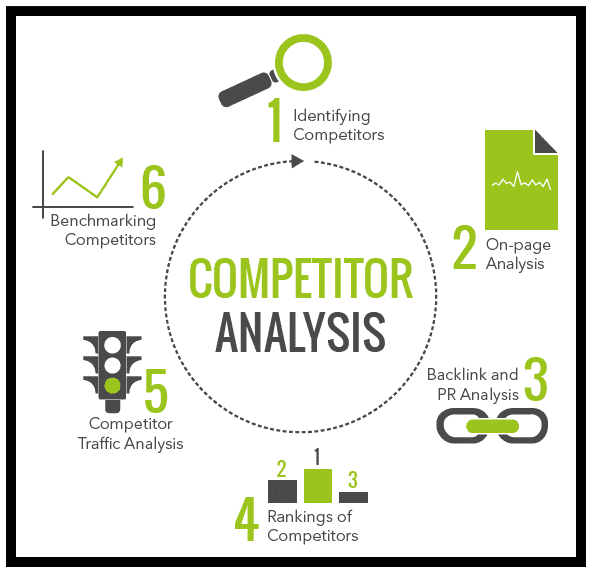Are you looking for a way to refine your online marketing? If so, then competitive research and analysis are exactly what you need to take advantage of.
Competitive research and analysis involves gathering and reviewing information about competing firms. They are essential marketing techniques that help you figure out what your competitors are doing and how their practices affect your business. Whether you’re looking to improve your content marketing, visual marketing, or any type of marketing, competitive research and analysis will prove of the utmost value in helping you increase conversions. You can take what you learn from your competitive research to tweak your own marketing campaigns and generate leads and increase revenue.
The Definition of Competition
Competitors are individuals or organizations that provide similar products or services as you. They don’t even have to be the same products, nor do they have to be marketed to the same audience. Any company that provides a product or service even remotely related to yours could be considered a competitor. Even if you haven’t entered a particular niche yet, you could consider companies working in that niche as potential competitors.
Competitors can be grouped into three main categories: primary, secondary and tertiary.
Primary competitors offer the same or similar products or services as you. They also target pretty much the same audience, which makes them your direct competitors.
Secondary competitors target a slightly different market segment. They may sell higher- or lower-end products, or they may sell a brand that is different from yours.
Tertiary competitors are those that offer products or services that are somehow related to yours.
If you sell pet supplies, for instance, a company that sells pet food or pet accessories could be considered a tertiary competitor. You could generally identify tertiary competitors by their potential value to your business or the likelihood that you will partner with them in the future.
Why Is Competitor Research Important?
Competitive research will give you valuable industry information that you wouldn’t get anywhere else. You can use the information you get to target your audience more effectively, serve your customers better, and avoid costly mistakes that your competitors have made.
Competitive research will also help you identify industry trends and effective business practices that you can then use in your own marketing efforts. By using the information you gain for marketing, product development, pricing, and so on, you could develop a significant edge over your competition.
How to Perform Competitive Analysis and Research on a Company
Identify Competitors
The first step in doing competitive research is identifying your competitors. Knowing who your competitors are will help you develop a more effective approach for retaining your audience and possibly even drawing them away from the competition.
There are many effective strategies for identifying competitors, from attending conferences to doing in-depth industry research. Both of these approaches certainly have their benefits. In many ways, there is nothing more effective than simply rolling up your sleeves, hunkering down, and doing a lot of old-fashioned research.
But these days, you will probably find most of the information you need on Google and Amazon. You can dig up a surprising amount of information by searching for specific products and business concepts. You could even find several companies in similar niches by searching for your business name. The goal is to pinpoint companies like yours and to copy off what they are doing right and to avoid what they are doing wrong in digital marketing. You will look at their visual marketing, including video marketing, as well as other forms of content marketing.
Research Competitor Websites and Marketing Channels
The process of identifying your competitors should give you an idea of where in the industry you choose to position yourself. The next step is to figure out what you are up against, which involves researching the websites and marketing channels of your competitors.
You will want to look into your competitor’s products and pricing structures. We’re going to go more into that later, but at this point, you should take note of how competing sites display their products and communicate product information.
Every bit of information you can obtain is valuable, from the photography to the product descriptions, and the site layout to the color scheme. Identifying common features and strategies and knowing what works and what doesn’t will help you develop your own marketing strategy and tell you which mistakes to avoid.
Compare Products and Prices
Products and pricing are so crucial to your marketing strategy that they deserve more focus when doing competitive research. Although you definitely want to give your customers the most value possible, you don’t necessarily want to bankrupt your company doing it!
Your pricing strategy is crucial to giving your business a competitive advantage. Checking out how your competitors price their products will give you a good idea of what your potential customers are willing to pay.
Always keep in mind the need to maintain a healthy profit margin to keep your business afloat. Competitive pricing isn’t always about having the lowest prices. If you offer higher quality products and services than your competitors, don’t be shy about pricing them accordingly.
Read Reviews or Speak with Competitor Customers
To get an accurate picture of how your competitors are serving their customers, you need to go straight to the source: the customers themselves. User reviews will tell you how satisfied – or dissatisfied – your competitors’ customers are with the products or services they are receiving.
Just as researching competing websites and social media channels, this will help you develop a more effective approach for dealing with your own customers.
Don’t just stop at customer reviews. Check out business reviews and comments on social media pages of competing firms as well.
Treat every review or testimonial as a valuable source of information. There’s no shame in adopting methods that have been proven to be effective. All is fair in love and war, and marketing. There is no need to reinvent the wheel if you can get some mileage from strategies that your competitors already implemented.
Create Alerts and Check in Frequently
Competitive analysis is a never-ending process. You should always keep tabs on what your competitors are doing, even if you’ve already hit on a winning formula for your own marketing. There is always something new to learn and some new market development to use in your campaign.
An easy way to keep track of the competition is to set up Google Alerts so that you will receive email updates based on specific keywords. You could set up alerts for your competitors’ brand names and standard industry terms, which let you know about new developments that could potentially affect your business.
A competitor analysis can help you uncover essential business insights that can inform other areas of marketing. You will benefit from partnering with a company that excels in full service marketing strategies when conducting a competitor analysis. You can use the results of the analysis to strengthen your video marketing strategy. The analysis will have a heavy influence on your content strategies, as well. You can use the results to understand how visual marketing can impact brand awareness, and you will better understand how engagement and traffic are not always the same. The analysis will help you determine what type of content is the most engaging, easily allowing you to devote your time and resources toward certain types of content creation that will prove a strong ROI. Even businesses that are brand new will benefit from a competitor analysis. You can research successful competitor campaigns while using the results to influence your SEO strategies.
Want to learn more about competitive research and how to better allocate your marketing budget toward content creation? Contact IGW today.







